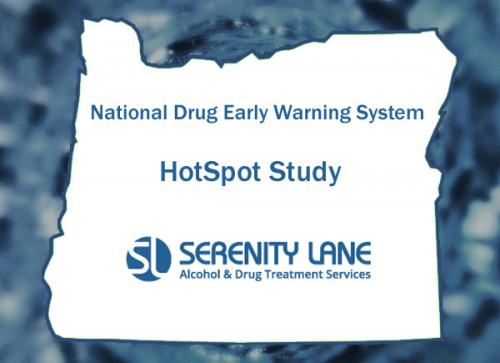Download: The Co-Use of Methamphetamine and Opioids Among Patients in Treatment in Oregon, USA
Contact: Monique Danziger
Director of Marketing and Communications
mdanziger [at] serenitylane.org
202-904-3113
High Rates of Combined Usage of Methamphetamines with Opioids in Oregon Reveals Regional, Behavioral and Demographic Factors: An NDEWS HotSpot Study
(September 16) College Park, MD—The National Drug Early Warning System Coordinating Center (NDEWS) at the University of Maryland, College Park, released the findings of their HotSpot study of drug use in Oregon. Based on site visits, 3 focus groups, and 9 interviews with Serenity Lane patients and counselors, the analysis found regional and demographic links to high rates of combined methamphetamine-opioid use. Study participants said that methamphetamine is seen as a safer alternative to heroin or is used to self-medicate while detoxifying from heroin. The specific combination of methamphetamine and heroin use was concentrated in young adult populations.
“Methamphetamine is seen as a tool for managing effects or aiding in self-detoxification from opioids,” said Andrea M. Lopez, PhD, who authored the study. “We must develop harm reduction strategies that address the needs of people who use methamphetamine and opioids and seriously evaluate what practical steps can be taken to address the stigma that people who use drugs face in and out of treatment contexts.”
The analysis also pointed to a potential barrier to patients seeking help for their substance use disorder, noting, “patients experience stigma related to methamphetamine, opioids, and the use of medication assisted treatment.” Additional key findings from the analysis include:
- Regional/geographic information is important for understanding patterns of methamphetamine use locally. For example, study participants reported that Springfield and Roseburg stand out as regional “hotspots.”
- Motivations for the co-use of methamphetamine and opioids include: 1) methamphetamine is seen as a safer alternative than heroin; 2) methamphetamine is seen as a strategy to detoxify or titrate the effects of heroin; 3) methamphetamine is seen as a financially beneficial way to maintain a desired high; and 4) there is easy access to purchasing methamphetamine and heroin in combination
- Polysubstance Use: Polysubstance use, with both methamphetamine and heroin as the primary drug used, tends to be concentrated in young adult treatment cohorts.
“Our outcome data has shown medication assisted treatment to be an effective treatment tool for improving our patient retention rates by nearly 50 percent,” said Dr. Eric Geisler, Serenity Lane’s Medical Director. “We are in the process of bringing more of these services to our outpatient offices. This analysis provides us with some exceptional insight for this process. The more we can meet patients where they are at and provide evidence-based, patient-centered care: the better the outcomes are going to be.”
These findings will be discussed during an NDEWS Presents webinar featuring Dr. Lopez on Wednesday, September 18, at 2:00pm Eastern. Free registration is available here: https://ndews.umd.edu/landingtopic/ndews-presents. The full report is available on the NDEWS website: https://ndews.umd.edu/sites/ndews.umd.edu/files/pubs/NDEWS-Hotspot-Serenity-Lane-Sept2019-FINAL.pdf. This analysis follows an earlier report that found high rates of opioids and methamphetamine in urine specimens from patients seeking treatment for a substance use disorder in Oregon, released in March. The original study was supported by funding from the Office of National Drug Control Policy. The follow-up HotSpot study is part of the NIH National Institute on Drug Abuse (NIDA) supported NDEWS.
--------------



